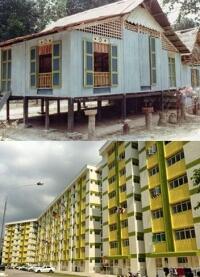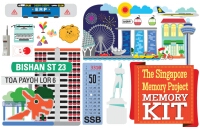
The First Trishaws
According to Singapore Infopedia, trishaws were first introduced in Singapore in 1914 as an improvised version to the two-wheel rickshaws. It had side chairs bolted to tricycle frames, and could be pedalled like bicycles. An American company apparently was keen to import 500 trishaws to Singapore but this request was rejected by the colonial government due to road safety issues.
However, in the local newspapers, “trishaw” was mentioned only in 1936 as a new type of vehicle that made its debut in Burma’s Rangoon. It was described as a further development of the rickshaw, fitted with a third wheel and propelled by pedals. It was able to cruise at 15 miles per hour (or 24km/h) speed on its three pneumatic tyres. Its inventor was said to be a Chinese resident in Burma, who had patented the new vehicle for use in British India and Burma.
Trishaws in Malaya
In British Malaya, 50 trishaws were introduced in Penang in 1936. Taiping had its first batch of 15 trishaws in 1941, whereas trishaws were brought into Singapore a year later, during the Japanese Occupation. The Syonan Times reported in 1942 that there were 48 trishaws plying the roads in Singapore.

Trishaws gained popularity rapidly, eventually replacing the rickshaws after the war. Bicycles, on the other hand, were still the most common mode of transport; the registered bicycles numbered 42,000 in September 1942.
In 1946, the Singapore Municipal Commission regulated the fares of the rickshaws and trishaws, after many complaints that the rickshaw pullers and trishaw riders were frequently demanding exorbitant charges. This was especially so during chaotic periods when bus companies put up strikes and disrupted the public transport system.
The regulations stated that the distance-based rickshaws and trishaws could not charge more than 20c per half mile. For those hired by time, the charge would be $1.50 per hour, and an additional 40c every subsequent 15 minutes. A rickshaw or trishaw hired for an entire day, regardless of distance, would cost a maximum of $6. For reference, a trishaw cost between $280 and $300 in the late forties, and could be rented out for $1 to $1.50 per day.
Rules and Regulations
In July 1946, the Municipal Commission decided not to renew the licenses of the 3,500 rickshaws in Singapore, as it was considered inhumane to treat the pullers as “beasts of burden” in this “degrading trade”. Rickshaws, therefore, would be officially phased out on 1 May 1947. In other parts of Malaya, rickshaws were banned in Malacca on 1 January 1948, followed by the ban of rickshaws in Penang in the same year.

The total number of registered trishaws in 1946 was 4,000. Due to impending ban of rickshaws, many rickshaw owners and pullers rushed to apply licenses to switch their vehicles to trishaws. In just a year, in 1947, the number of trishaws in Singapore more than doubled to 10,000, with 20,000 registered riders.
The oldest rickshaw puller at that time was 72-year-old Goh Ah Leng, who came to Malaya when he was 54 years old. He had previously worked as a sedan chair carrier in China. The rickshaw ban prompted him to retire and go back to China.
Besides the regulated fares, the Municipal Commission also imposed a list of rules for the trishaws, including the installation of efficient brakes, bells, and front and rear lamps. Every rider must wear a numbered arm badge that was visible at all times. No licenses would be granted to riders under 16 years old.

Trishaw riders were also required to pass a traffic test that comprise control of the trishaw, road sense, how to read the hand and light signals and knowledge of the rates of hire. Unlicensed trishaw riders were not permitted to ride on the Singapore roads.
In May 1947, 5,000 trishaw riders protested the new trishaw registration law and the hefty $5 registration fee, but the Municipal Commission stood firm in its decision. The trishaw riders also refused to wear the arm badges as they felt it was “humiliating”.
In 1948, the Municipal Commission added more rules, including the definition of trishaws as passenger-carrying vehicles and must not be used to carry goods only. It also ruled that trishaw riders must wear blue clothes, as a form of identification, starting from 1949.

The Singapore Rickshaw Owner’s Association, Singapore Trishaw Labour Union, Singapore Rick and Trishaw Workers’ Union, and Singapore Trishaw Owner’s Association were the major associations that looked after the interests of the rickshaw pullers and trishaw riders. This included subsidising the funeral expenses of a deceased member, or providing loans to a sick member to cover his medical expenditures.
Other than the more stringent rules and regulations, trishaw riders faced numerous issues during the forties and fifties. More riders means stiffer competition for customers; the riders often resort to aggressive touting and fights occasionally broke out.

There were extortions from the secret society members and gangsters too; although many of the riders themselves were part of the gangs. The riders also frequently flouted traffic rules, causing accidents and congestions and affecting other road users.
In 1949, the Singapore Commission proposed a third party insurance scheme to be taken up by each trishaw riders, much to the displease of the riders and their associations and unions. The insurance would be additional burden to their financial difficulties. The proposal was eventually dropped.
Trial of Trixis
 The Municipal Commission and Registry of Vehicles (ROV) did a trial run of motorised trishaws (nicknamed “trixis” or “trishaw-taxis”) in 1950. “Trixis” were commonly found elsewhere in Bangkok, Saigon, Hong Kong and Indonesia.
The Municipal Commission and Registry of Vehicles (ROV) did a trial run of motorised trishaws (nicknamed “trixis” or “trishaw-taxis”) in 1950. “Trixis” were commonly found elsewhere in Bangkok, Saigon, Hong Kong and Indonesia.
George Lee Motors brought a small number of motorised trishaws into Singapore, but the attempt to introduce this new vehicle on a massive scale was strongly protested by the traditional trishaw riders and taxi drivers. In 1951, the Municipal Commission decided to scrap the “trixis” proposal.
Tourist Attraction
In 1954, almost 7,000 trishaw riders generously donated their entire day’s earning, along with the likes of shopkeepers, street hawkers and taxi drivers, for the building of the new Nanyang University.
Buses and taxis had become more common in the sixties, offering passengers speedier rides with competitive fares as compared to the slow and outdated trishaws. This caused the trishaw population to decline to around 3,000. The number dropped further to less than 2,000 by the end of the seventies. Many trishaw riders were struggling and living hand-to-mouth in this declining trade.
The trishaw business was given some revival hope in 1965, shortly after Singapore’s independence. The newly-set up Singapore Tourist Promotion Board (STPB) identified trishaws as “great tourist attractions”. At some of the leading hotels, designated trishaw stands were built for tourists to take the trishaws for some sightseeing tours of the Chinatown and city area.


Singapore also featured a trishaw as one of its attractions at the Expo ’70 held at Osaka, Japan. In 1973, Singapore presented a trishaw to a French museum during the Jaycees World Congress. Another trishaw was displayed by STPB at the Singapore Fair ’76 in Tokyo’s Toshima-en Amusement Park.
There was even a “cleanest trishaw” competition in 1968, organised by the ROV as part of “Keep Singapore Clean” campaign. 41-year-old trishaw rider Ong Ah Lock, with his gleaming blue trishaw, came in first and was awarded $60 in prize money.

In the seventies, the University of Singapore’s (NUS) Student Union organised the Trishaw Pageant as a means to foster the cultural and social aspects of the Singapore society. Held annually, it featured a convoy of trishaws that displayed different national themes of slogans and undergrads in their fancy dresses. The trishaw parade would travel from NUS’s Bukit Timah campus to Orchard Road, attracting huge crowds along the way.
In December 1974, the trishaws were banned from plying along the major and congested roads during peak hours. Some of the roads listed in the ban were Bra Basah Road, Victoria Street, New Bridge Road, Robinson Road and North and South Bridge Roads.

Another new rule under Road Traffic (Public Service Vehicles) (Vocational Licenses and Conduct of Drivers, Conductors and Passengers) (Amendment) Rules was implemented in 1977, setting an age limit for the licensing of public service vehicle drivers and trishaw riders. They could no longer drive these vehicles on the roads after the age of 70.
The seventies and eighties witnessed Singapore’s booming tourism industry but this also led to numerous complaints of taxi drivers and trishaw riders overcharging and extorting the tourists.

One 1981 case even involved the Interpol when a couple of Japanese tourists were forced to pay $310 each for trishaw rides from King’s Hotel to the Singapore Handicraft Centre at Tanglin Road. In 1982, an American university professor was demanded $128 for a two-hour trishaw ride in town. The increasing number of such cases damaged Singapore’s reputation as a tourist destination.
As a result, Operation Trishaw was carried out in 1982 by the ROV and Tanglin Police to round up the unlicensed trishaw riders and those who charged exorbitant fares from their passengers. 12 trishaw riders were caught in the operation.

In 1987, the ROV approved the displaying of advertisements on trishaws in Singapore. Japanese camera and film maker Konica was the first to advertise on trishaws. This brought an additional income of $50 per month for each of the selected 150 trishaw riders.
According to ROV’s 1988 Annual Report, there were only 533 licensed trishaw riders left in Singapore. Hock Sin Hin, located at Joo Chiat Road, was the last shop in Singapore to assemble, repair, rent and sell trishaws. Its business was started half a century ago in the 1930s.

In the nineties, STPB licensed three travel agents – Trishaw Tours Pte Ltd, Triwheel Tours Pte Ltd and Pedicab Tours Pte Ltd – to operate trishaw tours in Singapore.
Trishaw Uncle, the sister company of Singapore River Cruises Leisure, was established in 2010. With its fleet of 100 trishaws, the company hoped to revitalise the nostalgic scene of old Singapore with city tours for the tourists. The Singapore Tourism Board (formerly STPB and renamed STB in 1997) appointed it to manage the Albert Mall Trishaw Park at Queen Street.

However, in May 2023, Trishaw Uncle, by then the only licensed trishaw operator left in Singapore, had its license ended and not renewed. Its trishaw tours were halted, with most of its trishaws scrapped. Once a common mode of public transport in Singapore for many decades, trishaws would likely disappear from the roads forever.
Published: 11 May 2024

























 In 1973, Peace Centre’s front podium was completed. It had shops, supermarket, medical specialist centre, eateries, offices and even a 36-lane bowling centre called Star Bowl. Peace Mansion was completed in 1977.
In 1973, Peace Centre’s front podium was completed. It had shops, supermarket, medical specialist centre, eateries, offices and even a 36-lane bowling centre called Star Bowl. Peace Mansion was completed in 1977.
















































































































